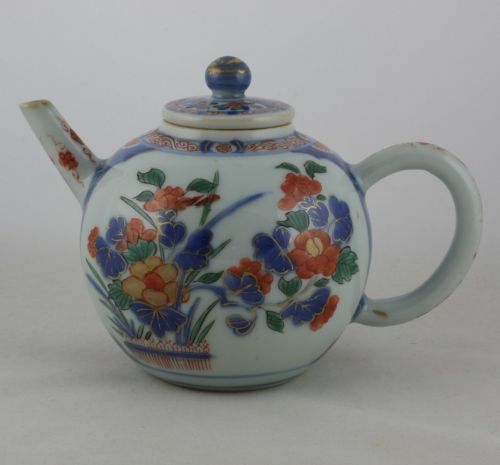
Sold Ceramics - Sold Chinese Imari 1700-1800 - Tea, Coffee and Chocolate wares - Page 2
Object 2011947
Teapot
China
1710-1720
Height including the cover 119 mm (4.69 inch), diameter handle to spout 175 mm (6.89 inch), diameter of mouthrim 43 mm (1.69 inch), diameter of footring 52 mm (2.05 inch), weight with cover 414 grams (14.60 ounce (oz.)), weight cover 39 grams (1.38 ounce (oz.))
Teapot of globular shape on footring with low rim and a flat cover with round knob. Straight spout with a curved C-shaped handle. Chinese Imari, decorated in underglaze blue, iron-red, green and black enamel and gold enclosing two panels, one with a flowering chrysanthemum growing from a brushwood fence, the other with a flowering peony growing from a brushwood fence. The panels are divided by golden scrolls and half flower heads on an underglaze blue ground. On the handle and spout florets between scrolls. The cover is decorated en suite.
This brushwood fence, made up of bundles of twigs tied together is frequently combined with a bamboo trellis, an enlarged branch of a flowering peony tree and a shishi. It is a motif that occurs frequently on Kakiemon, and one which evidently appealed greatly to the European consumer, given the fact that it is often seen on European imitations of Kakiemon. (Fitski 2011, p.148)
Japanese Imari was exported to Europe from the last quarter of the 17th century by the Dutch. The Chinese began copying Imari porcelain - far more cheaply, just as adeptly and in an ever larger range of shapes - in the early 18th century. The early 18th century has left little written documentary evidence of Chinese Imari. It was often entered as Japanese in inventories such as those drawn up at Dresden, whilst in shipping lists it was not described in sufficient detail to be identified. Dutch private traders began importing enormous quantities of imari of around 1720. Their shapes were likewise often geared towards European source material in silver, stoneware or glass. (Düsseldorf 2015, pp.222-223)
For a pair of bowls, decorated in the same style, please see:
Condition: Three firing flaws to the underside of the cover and a few very shallow rough spots to the footring.
References:
Düsseldorf 2015, pp.222-223 & cat.126
Price: Sold.


 create websites
create websites